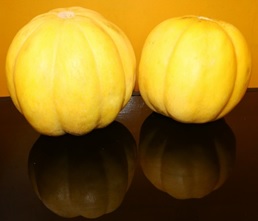Selection of half-sib families of creole melon (Cucumis melo L.) on the Ecuadorian coast

Abstract
The creole melon cantaloupe is a horticultural species, whose fruits are used for human nutrition. However, no research has been reported on their genetic variability for starting breeding processes. The objective of this study was to take advantage of the variability of creole melons for genetic improvement. 20 creole melon half-sib families were selected and evaluated for production characteristics and fruit quality in order to obtain improved populations. The study was carried out in Palenque canton, Ecuador. Seeds from 20 half-sib families were used, arranged in a randomized complete block design with three replications. The differences between the families were significant for all the studied characteristics. Family 93 presented higher averages for fruit weight, fruit diameter and production (per hectare), and family 196 did so for soluble solids. The phenotypic correlations were positive and significant between the fruit weight and fruit diameter, fruit length, pulp thickness, fruit cavity, soluble solids and production. The coefficients of genetic variation, in general, were lower than the coefficients of environmental variation. The estimates of heritability broadly had a moderate magnitude (30-60%) for the 10 evaluated characteristics, and the magnitude of the expected genetic progress was low (<10%) for the fruit weight, production, and soluble solids, so the selection for high production should focus on fruit weight and soluble solids.
Keywords
Slice melon, Genetic variability, Heritability, Genetic gain
References
- Abraham-Juárez, M. del R. et al., 2018. Development, yield, and quality of melon fruit (Cucumis melo L.) inoculated with mexican native strains of Bacillus subtilis (Ehrenberg). Agrociencia, 52, No1, pp.91–102. Available at: https://dialnet.unirioja.es/servlet/articulo?codigo=6328112.
- Anon, 2018. FAOSTAT, Roma: FAO. Available at: http://www.fao.org/faostat/en/#data/QC.
- Aragão, F.A.S. de, Nunes, G.H. de S. & Queiróz, M.A. de, 2015. Genotype x environment interaction of melon families based on fruit quality traits. Crop Breeding and Applied Biotechnology, 15(2), pp.79–86. Available at: http://www.scielo.br/scielo.php?script=sci_arttext&pid=S1984-70332015000200079&lng=en&nrm=iso&tlng=en.
- Chacón, X. & García, M., 2016. Redes de custodios y guardianes de semillas y casas comunitarias de semillas nativas y criollas SWISSAID y. J. A. Gómez & W. Peréz, eds., Bogota. Available at: https://www.google.com/search?q=articulo+variedades+criollas+de+melon&ie=utf-8&oe=utf-8&client=firefox-b-ab&gfe_rd=cr&dcr=0&ei=H23DWq-JIcygMrbLtbgD.
- Díaz-Alvarado, J.M. & Monge-Pérez, J.E., 2017. Efecto de la poda y la densidad de siembra sobre el rendimiento y calidad de melón Cantaloupe ( Cucumis melo L .) cultivado bajo invernadero Effect of pruning and plant density on yield and quality of Cantaloupe melon ( Cucumis melo L .) grown under green. Revista Colombiana de Ciencias Hortícolas, 11(1), pp.21–29.
- Eguiarte, L.E. et al., 2013. Genómica de poblaciones: nada en evolución va a tener sentido si no es a la luz de la genómica, y nada en genómica tendrá sentido si no es a la luz de la evolución. , 16(1), pp.42–56. Available at: http://www.scielo.cl/pdf/ciagr/v35n3/art03.pdf.
- FAO, 2014. Anuario Estadístico de la FAO. La Alimentación y la Agricultura en América Latina y el Caribe, Santiago: Oficina Regional de la FAO para América Latina y el Caribe.
- Gobierno autónomo descentralizado del cantón Quevedo, 2014. Plan de desarrollo y de ordenamieto territorial D. de P. y G. Municipal, ed., Quevedo: Gobierno autonomo descentralizado del cantón Quevedo.
- Guis, M. et al., 1998. Melon biotechnology. Biotechnology and Genetic EngineeringReviews, 15, pp.289–311. Available at: http://www.scopus.com/scopus/inward/record.url?eid=2-s2.0-0031948438&partnerID=40.
- INAMHI, 2016. Boletin climatio semestral 2016. , pp.1–26. Available at: http://www.serviciometeorologico.gob.ec/clima/.
- Latrasse, D. et al., 2017. The quest for epigenetic regulation underlying unisexual flower development in Cucumis melo. Epigenetics and Chromatin, 10(1), pp.1–18.
- Monge, J.E., 2016. Evaluación de 70 genotipos de melón (Cucumis melo L.) cultivados bajo invernadero en Costa Rica. InterSedes, 17(36), pp.73–112. Available at: http://revistas.ucr.ac.cr/index.php/intersedes/article/view/26944.
- Monge Perez, E.J., 2013. Producción y exportación de melón ( Cucumis melo ) en Costa Rica. Tecnología en Marcha, 27(506), pp.93–103.
- Pavan, S. et al., 2017. Genotyping-by-sequencing of a melon (Cucumis melo L.) germplasm collection from a secondary center of diversity highlights patterns of genetic variation and genomic features of different gene pools. BMC Genomics, 18. Available at: https://bmcgenomics.biomedcentral.com/track/pdf/10.1186/s12864-016-3429-0 [Accessed April 2, 2018].
- Pistorale, S.M., Abbott, L.A. & Andres, A., 2008. Diversidad genética y heredabilidad en sentido amplio en agropiro alargado , Thinopyrum ponticum. Cien. Inv. Agr., 35(3), pp.259–264. Available at: http://www.scielo.cl/pdf/ciagr/v35n3/art03.pdf.
- POV. Unión Internacional para la Protección de las Obtenciones Vegetales, 2008. Cuadragésima primera sesión ordinaria Ginebra, 25 de octubre de 2007, Ginebra. Available at: http://www.upov.int/edocs/mdocs/upov/es/c/41/c_41_12_add.pdf.
- Praveen, B. et al., 2013. Correlation and path coefficient analysis in muskmelon ( Cucumis melo L .). , 20(2), pp.135–149.
- Rakhi, R. & Rajamony, L., 2005. Short communication Variability , heritability and genetic advance in landraces of culinary melon ( Cucumis melo L .). , 43, pp.79–82.
- Reddy, B.P.K. et al., 2013. Variance Component Analysis of Quantitative Traits in Muskmelon ( Cucumis Melo L .). , 11(2), pp.118–124.
- Sebastian, P. et al., 2010. Cucumber (Cucumis sativus) and melon (C. melo) have numerous wild relatives in Asia and Australia, and the sister species of melon is from Australia. Proceedings of the National Academy of Sciences, 107(32), pp.14269–14273. Available at: http://www.pnas.org/cgi/doi/10.1073/pnas.1005338107.
- Stalker, H. y Chapman, C., 1989. Scientific Management of Germplasm: Characterization, Evaluation and Enhancement N. C. S. U. IBPGR with the Department of Crop Science, ed., North Carolina: Cornell University.
- Wang, Y.-H. et al., 2016. Mapping quantitative trait loci for fruit traits and powdery mildew resistance in melon (Cucumis melo). Botanical Studies, 57(1), p.19. Available at: http://as-botanicalstudies.springeropen.com/articles/10.1186/s40529-016-0130-1.
